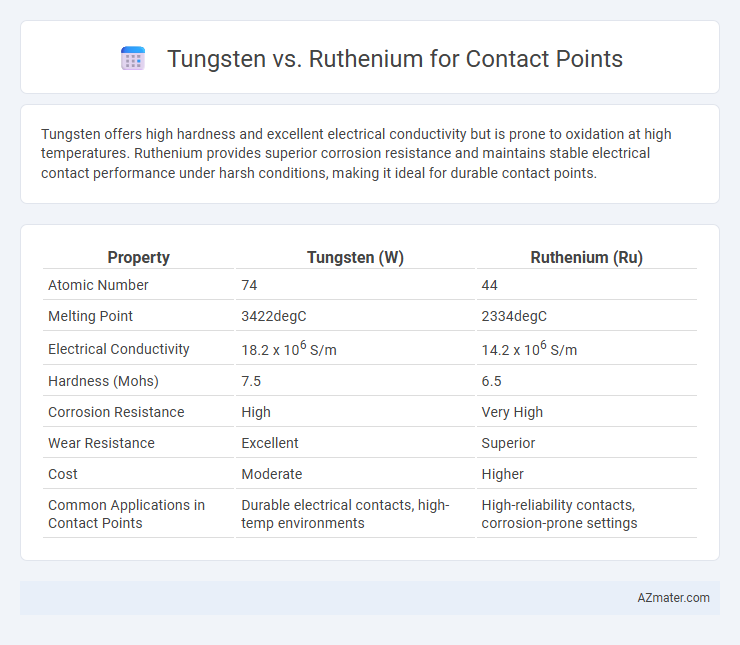Tungsten offers high hardness and excellent electrical conductivity but is prone to oxidation at high temperatures. Ruthenium provides superior corrosion resistance and maintains stable electrical contact performance under harsh conditions, making it ideal for durable contact points.
Table of Comparison
| Property | Tungsten (W) | Ruthenium (Ru) |
|---|---|---|
| Atomic Number | 74 | 44 |
| Melting Point | 3422degC | 2334degC |
| Electrical Conductivity | 18.2 x 106 S/m | 14.2 x 106 S/m |
| Hardness (Mohs) | 7.5 | 6.5 |
| Corrosion Resistance | High | Very High |
| Wear Resistance | Excellent | Superior |
| Cost | Moderate | Higher |
| Common Applications in Contact Points | Durable electrical contacts, high-temp environments | High-reliability contacts, corrosion-prone settings |
Introduction to Tungsten and Ruthenium for Contact Points
Tungsten and Ruthenium are critical materials used in contact points for electrical applications due to their exceptional hardness and resistance to wear. Tungsten offers high melting points and excellent conductivity, making it suitable for high-temperature environments. Ruthenium, a rare platinum-group metal, enhances durability and corrosion resistance when alloyed with other metals in contact points, ensuring reliable electrical performance under demanding conditions.
Material Properties Overview
Tungsten exhibits exceptional hardness and a high melting point of 3422degC, making it ideal for contact points requiring durability and resistance to wear. Ruthenium, part of the platinum group metals, offers superior corrosion resistance and excellent electrical conductivity, with a melting point of 2334degC, enhancing the longevity of electrical contacts in harsh environments. Both materials provide unique advantages, but tungsten's robustness suits high-temperature applications while ruthenium excels where oxidation resistance and stable conductivity are critical.
Electrical Conductivity Comparison
Tungsten exhibits an electrical conductivity of approximately 18.2% IACS (International Annealed Copper Standard), whereas Ruthenium offers slightly higher conductivity at about 20-30% IACS, making Ruthenium more efficient for electrical current flow in contact points. Despite Tungsten's superior melting point and mechanical strength, Ruthenium's enhanced conductivity reduces contact resistance and energy loss in electrical circuits. This makes Ruthenium preferable in applications where minimizing electrical resistance and enhancing signal integrity are critical.
Mechanical Strength and Durability
Tungsten exhibits exceptional mechanical strength with a tensile strength of approximately 550 MPa and excellent wear resistance, making it ideal for high-stress electrical contact points. Ruthenium, a platinum-group metal, offers superior durability and corrosion resistance, extending contact life in harsh environments with minimal degradation. The dense atomic structure of ruthenium enhances its electrical conductivity while providing robustness against mechanical deformation, whereas tungsten provides cost-effective strength but with less resistance to oxidation.
Corrosion and Oxidation Resistance
Tungsten exhibits excellent oxidation resistance up to 600degC but forms a surface oxide layer that can impact electrical conductivity, limiting its effectiveness in high-corrosion environments. Ruthenium demonstrates superior corrosion resistance and maintains stable electrical contact properties due to its robust oxide film, making it ideal for harsh or oxidizing conditions. The choice between tungsten and ruthenium for contact points depends on the specific operating environment, with ruthenium preferred for enhanced durability against corrosion and tungsten favored for high-temperature applications.
Thermal Stability and Heat Tolerance
Tungsten exhibits exceptional thermal stability with a melting point of 3422degC, making it highly suitable for contact points operating under extreme heat conditions. Ruthenium, with a melting point of 2334degC, offers good heat tolerance but is less resistant to thermal degradation compared to tungsten. The superior thermal conductivity and oxidation resistance of tungsten further enhance its performance in high-temperature electrical contacts.
Cost and Availability
Tungsten offers a lower-cost option for contact points compared to ruthenium due to its more abundant availability and well-established supply chains. Ruthenium, though more expensive, provides superior corrosion resistance and longevity, making it suitable for high-performance or specialized applications despite its limited global supply. Cost efficiency favors tungsten in mass production, while ruthenium's rarity and premium price often restrict its use to niche markets.
Applications in Industry
Tungsten's high melting point and exceptional hardness make it ideal for contact points in high-temperature industrial applications such as electrical switches and welding electrodes. Ruthenium offers superior corrosion resistance and excellent conductivity, enhancing the durability and performance of contact points in harsh environments like aerospace and chemical processing. Both metals are critical in electronics and telecommunications, where precise, reliable electrical contacts are essential for device longevity and efficiency.
Environmental and Safety Considerations
Tungsten offers exceptional durability and corrosion resistance, but its extraction and processing involve significant environmental impacts due to energy-intensive mining and potential release of toxic byproducts. Ruthenium, a rare platinum-group metal, poses fewer direct environmental hazards during use but raises concerns about resource scarcity and ecological disruption from limited, concentrated mining locations. Safety considerations emphasize tungsten's high melting point and stability under extreme conditions, whereas ruthenium's catalytic properties demand careful handling to avoid exposure to hazardous compounds during manufacturing and disposal.
Conclusion: Choosing Between Tungsten and Ruthenium
Tungsten offers excellent durability and high melting point, making it ideal for contact points in high-temperature and high-wear applications. Ruthenium provides superior corrosion resistance and lower contact resistance, enhancing electrical conductivity and longevity in precision devices. Selecting between tungsten and ruthenium depends on the specific operational environment: tungsten suits heavy-duty, thermal-intensive uses while ruthenium excels in environments requiring reliable conductivity and corrosion resistance.

Infographic: Tungsten vs Ruthenium for Contact Point
 azmater.com
azmater.com